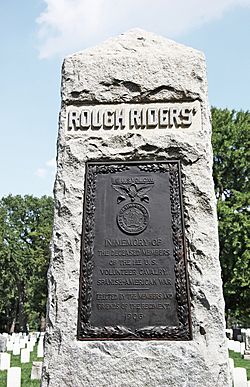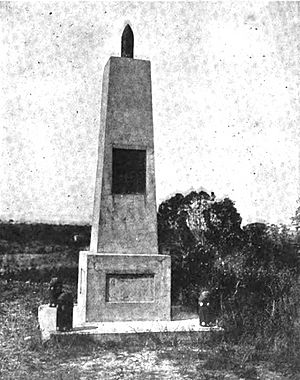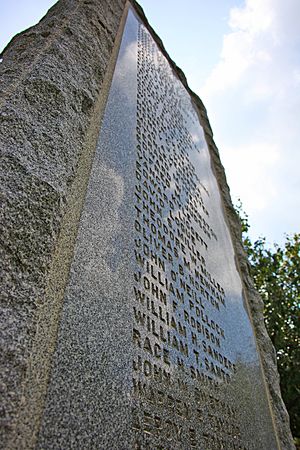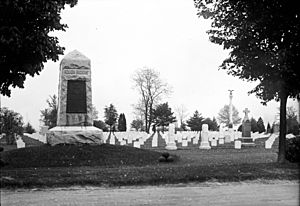Rough Riders Memorial facts for kids
Quick facts for kids Rough Riders Memorial |
|
|---|---|
| United States | |

Rough Riders Memorial in 2011
|
|
| For members of the Rough Riders who died in the Spanish–American War | |
| Unveiled | April 12, 1907 |
| Location | 38°52′32″N 77°04′34″W / 38.875429°N 77.075989°W near |
The Rough Riders Memorial is a special monument located in Arlington National Cemetery in Arlington County, Virginia. It honors the brave members of the "Rough Riders" who died during the Spanish–American War in 1898. This tall, grey granite monument was built by the surviving Rough Riders and their friends.
Even though some records and the monument's own plaque say it was dedicated in 1906 (or even 1905), old newspaper stories from that time show it was actually dedicated on April 12, 1907.
Contents
Who Were the Rough Riders?
The Spanish–American War was a short conflict in 1898, lasting only ten weeks. It happened because Cuba was fighting for its freedom from Spain, and the United States supported Cuba. The U.S. had many businesses in Cuba and wanted to protect its citizens there.
In January 1898, the U.S. sent the battleship USS Maine (ACR-1) to Cuba. On February 15, the Maine exploded, and many lives were lost. This event led to the U.S. and Spain declaring war on each other on April 25.
At the time, the United States Army was small, with only about 25,000 soldiers. But the war needed over 100,000 men! Theodore Roosevelt, who was then the Assistant Secretary of the Navy, had an idea. He convinced the Secretary of War, Russell A. Alger, that he could gather 1,000 volunteers to form a cavalry regiment.
Roosevelt was offered a high rank, but he turned it down. Instead, he resigned his Navy job and became a lieutenant colonel of volunteers. He let his friend, Colonel Leonard Wood, lead the regiment because he felt he didn't have enough military experience.
The regiment's official name was the "1st United States Volunteer Cavalry." But newspapers quickly gave them the nickname "Rough Riders." This was because most of the men were cowboys, frontiersmen, railroad workers, Native Americans, and other "rough" people from the American West.
The 1,060 Rough Riders left their training camp in San Antonio, Texas, on May 29, 1898. They arrived in Santiago de Cuba, Cuba, on June 19. They fought in the Battle of Las Guasimas on June 24, where they helped push back a Spanish force. On July 1, they were part of the famous Battle of San Juan Hill. During this battle, they successfully charged up Kettle Hill, which was part of the larger San Juan Hill battle, and defeated another Spanish force.
Early Rough Rider Monuments in Cuba
Two monuments honoring the Rough Riders were built in Cuba soon after the war ended. One was put up by Brigadier General Wood near the Spanish Army blockhouse on San Juan Hill. This monument was a tall, square column with a bronze plaque. The plaque honored all U.S. Army officers and men who died during the battles in Santiago.
Another monument, specifically for the Rough Riders, was built at Las Guasimas. This one was also a tall, tapered column, but it was made of rough-hewn granite. It had an artillery shell on top and a bronze plaque. This plaque honored the men of the First and Tenth United States Cavalry who died in the Battle of Las Guásimas.
Building the Rough Rider Memorial
It's not clear who first thought of building a Rough Rider Memorial in the U.S., or when the idea came up. A group called the Rough Riders National Monument Society was formed on June 15, 1906. Lillian Capron, whose husband was the first Rough Rider officer killed in action, became the president. Many other former Rough Riders were also part of the society.
Getting permission to build the memorial at Arlington National Cemetery was likely easy. The cemetery was controlled by the U.S. Army at the time. Theodore Roosevelt was President, and William Howard Taft, the Secretary of War, was his close friend. Permission was probably given in May or June 1906. The first fundraising event for the memorial was even announced before the society was officially formed.
Mrs. Capron designed the Rough Rider Memorial. She based it on the monument General Wood had built in Cuba. The bronze plaque on the memorial was designed by Army officers Major J.T. Knight and Major S.L. Fairson.
Money was raised to pay for the memorial. On June 10, 1906, Mrs. Capron held a party where a saber was raffled off, items were sold, and the United States Marine Band played music. President Roosevelt even donated many "American Beauty" roses from the White House Rose Garden. Another fundraiser happened on February 8, 1907, with a horsemanship show by the 13th Cavalry and the 4th Battery, U.S. Light Field Artillery at Fort Myer. President Roosevelt and many important people from Washington attended, raising a lot of money.
Construction of the Memorial
The Rough Riders Memorial was made from grey granite stone from Barre, Vermont. The stone arrived at Arlington National Cemetery by February 6, 1907. The bronze plaque was planned to have the Rough Riders' symbol and a message: "In memory of the deceased members of the First United States Volunteer Cavalry, Spanish–American War. Erected by the members and friends of the regiment."
The foundation for the monument was laid on March 27, 1907. Mrs. Capron and others were there. A special bronze box, like a time capsule, was placed under the monument. It held copies of Washington, D.C. newspapers, an American flag, U.S. silver coins, and a copy of Theodore Roosevelt's book, The Rough Riders in Cuba. President Roosevelt himself signed the book, along with other important people.
Dedication Ceremony
The Rough Riders Memorial was officially unveiled and dedicated on April 12, 1907, at 4:30 P.M. A committee planned the event, and Major General George Herbert Harries helped organize it.
Many military groups were present, including artillery, cavalry, and National Guard units. Several bands played music. Seven Rough Riders were already buried nearby, and their graves were decorated with yellow and white flowers, the colors of their regiment.
A 21-gun salute welcomed President Roosevelt. He was joined by important military leaders. After music, a prayer was given, and the crowd sang Nearer, My God, to Thee. Then, Mrs. Capron unveiled the memorial as the bands played The Star Spangled Banner.
President Roosevelt gave a long speech about patriotism and duty. After more music, a bugler played Taps, and another 21-gun salute ended the ceremony. Many important people attended, including Cabinet members, military leaders, and ambassadors from other countries. Many former Rough Riders were also there.
About the Memorial
The Rough Riders Memorial is a grey granite block about 14 feet (4.3 m) tall. It looks a lot like the Rough Rider monument built in Cuba. Most of the monument is rough, but the panels on the north, south, and east sides are smooth. These panels have the names of the fallen soldiers carved into them.
On the front (western side) of the memorial, near the top, are the words "ROUGH RIDERS'" carved into the stone. Below this is a dark bronze plaque decorated with laurel leaves, which symbolize victory. At the top of the plaque, it says "1st. U.S. Vol. Cav." Below that are crossed sabres with outspread wings. The regiment's symbol hangs from the sabres, with "RR" (for Rough Riders) and the names of their three main battles: Las Guasimas, San Juan Hill, and Santiago.
The words on the plaque read:
- In memory of
- The deceased members
- of the 1st U.S.
- Volunteer Cavalry,
- Spanish–American War
- Erected by the members and
- friends of the regiment.
- 1906.
When it was unveiled, the names of over 100 men were carved into it. The memorial cost $2,500 to build.
The Rough Rider Monument Society planned to add the names of more regiment members as they passed away. They set up a fund to pay for this. Even after the dedication, they continued to raise money. Another military horsemanship show was held in December 1907, where President Roosevelt donated $100 to help pay off the debt for the memorial. Another fundraiser, also attended by President Roosevelt, happened in April 1908.
In August 1927, about 400 living Rough Riders gathered at Arlington National Cemetery for General Leonard Wood's funeral. For many, it was their first time seeing the Rough Riders Memorial.
In the early 2000s, the memorial's bronze plaque and carvings were cleaned and preserved by Gordon Ponsford, an expert restorer.
When Was It Dedicated?
There's often confusion about when the Rough Rider Memorial was dedicated. The bronze plaque on the monument itself says "1906." Arlington National Cemetery and some historians also say it was dedicated in 1906, and one source even claims 1905.
However, old newspaper reports clearly show the memorial was dedicated on April 12, 1907. President Roosevelt's own collection of speeches also confirms this date. Historians also note that another Rough Rider monument in Prescott, Arizona, was dedicated in the same year, 1907.
The Washington Post newspaper reported on March 28, 1907, that the memorial's bronze plaque said "1906," even though the dedication was still to come.




